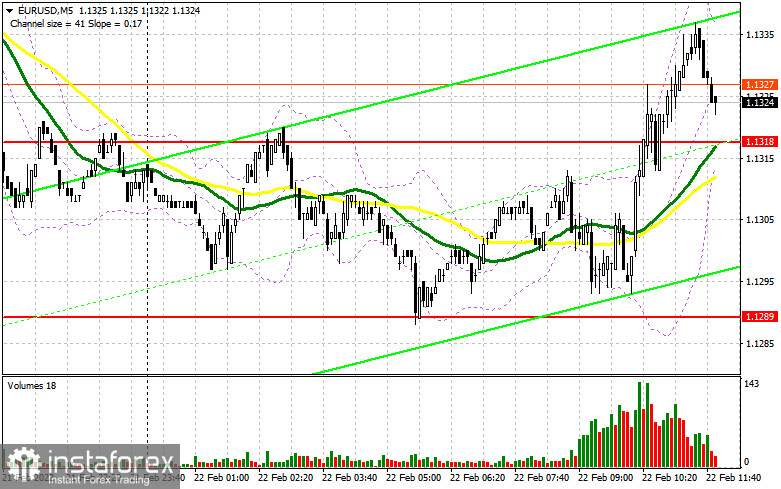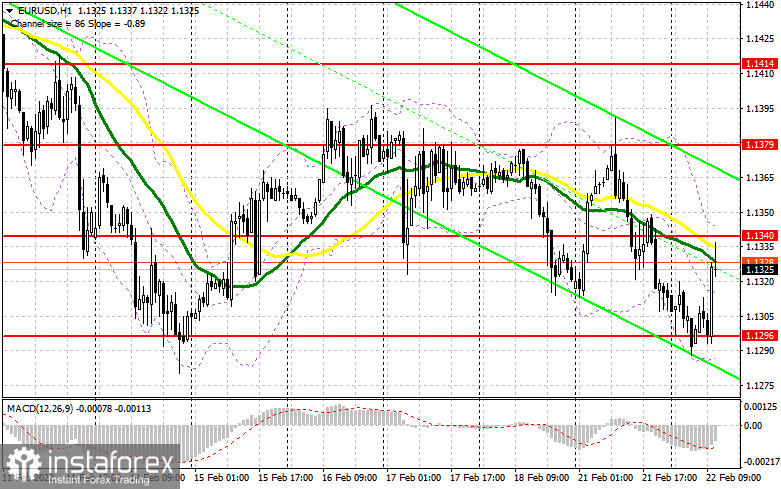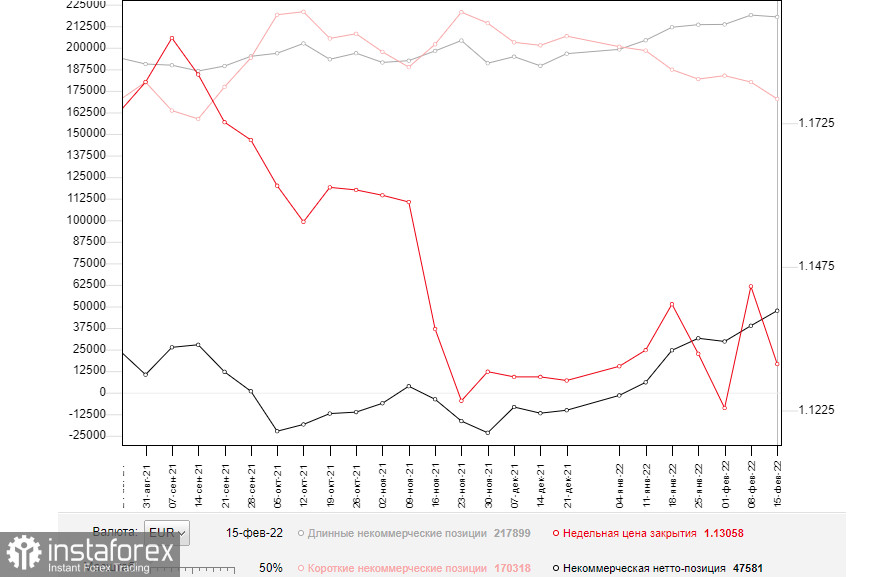Long positions on EUR/USD:
In my forecast this morning, I drew attention to the level of 1.1318 and recommended entering the market from it. Let's look at the 5-minute chart and analyze what happened. The strong German data pushed the euro up during the European session, but the second half of the day may reverse the trend. A breakout and fixation above 1.1318 occurred without a reverse test, so there were no entry points into long positions. The first half of the day showed no trading activity, so for the US session, the technical picture was completely revised.
The risk of further decline of the euro remains quite high, so those purchases, which could be observed in the first half of the day, do not make any difference yet. The worsening conflict between Russia and Ukraine, which may even turn into war, creates pressure on certain risky assets including the euro. US economic data will be released later, which might bring back demand for the US dollar right away. A strong report on consumer confidence indicators is likely to push the EUR/USD pair lower. In the second part of the day, bulls need to hold the price above support at 1.1296, formed in the first half of the day. Only a false breakout of this level will form an entry point for opening long positions, allowing an upward correction. However, the EUR/USD pair may show a larger recovery and break through the sideways channel if more active buyers and a breakout of resistance at 1.1340 occur. Below this level, there are the moving averages limiting the upside movement of the pair. A breakout and test of 1.1340, together with weak manufacturing activity index, PMI for services, and US composite PMI - all of this will lead to another buy signal and open the way to the recovery towards the area of 1.1379, where traders may take profit. The pair is unlikely to reach above this range because its breakdown will resume the bullish trend and open a way to the highs at 1.1414 and 1.1452, where traders may generate profit. However, as I mentioned above, geopolitical tensions are highly likely to affect the growth of the euro. If the Russia-Ukraine conflict worsens, demand for the US dollar may return. If the pair decreases during the US session and there is no activity at 1.1296, it may plummet significantly. Therefore, it is better to postpone the opening of long positions until the false breakout at 1.1245 happens. Traders can also buy the euro on the rebound from 1.1201, or even lower - at 1.1154, allowing an upward intraday correction of 20-25 pips.
Short positions on EUR/USD:
Bears have not shown any activity near the weekly low yet, and good Eurozone data discouraged the market players. As long as the pair is trading below 1.1340, we can expect the pair to fall. With quite interesting data to be released later the volatility is expected to be quite high. We might expect that the pair will go back to the low of the week and pierce it from above. However, bears need to protect the resistance at 1.1340. A false breakout of this level, similar to the one that I mentioned above, as well as strong data on the consumer confidence indicator in the US will be a signal for the opening of short positions, aiming for the EUR/USD to go down to 1.1296. A breakthrough of this area and a reverse test from bottom/top may create an additional signal for opening short positions, with the target at the low of 1.1245. The next target is located at 1.1201, but its test is highly possible if the military conflict in Ukraine aggravates. I recommend locking in profits at 1.1201. If the euro grows during the US session and lacks activity of bears at 1.1340, it is better to postpone selling the pair. The optimal scenario would be to take short positions if a false breakout occurs around 1.1379. Selling the euro immediately on a rebound is possible from 1.1414, or even higher at 1.1452, allowing a downward correction of 15-20 pips.


Indicator Signals:
Moving averages
Trading is carried out near the 30 and 50 MA's, indicating uncertainty in the market.
Note: The period and prices of moving averages are considered by the author on hourly chart H1 and differ from the common definition of classic daily moving averages on daily chart D1.
Bollinger Bands
A breakthrough of the upper boundary of the indicator at 1.1340 may lead to further growth of the euro. In the case of a decline, the lower boundary of the indicator at 1.1285 will be a support level.
Description of indicators
- Moving average (moving average determines the current trend by smoothing out volatility and noise). Period 50. It is marked in yellow on the chart;
- Moving average (moving average determines the current trend by smoothing out volatility and noise). Period 30. It is marked in green on the chart;
- MACD (Moving Average Convergence/Divergence - moving average convergence/divergence) Fast EMA period 12. Slow EMA period 26. SMA period 9
- Bollinger Bands (Bollinger Bands). Period 20;
- Non-commercial traders are speculators, such as individual traders, hedge funds, and large institutions, which use the futures market for speculative purposes and meet certain requirements;
- Long non-commercial positions represent the total long open position of non-commercial traders;
- Short non-commercial positions represent the total short open position of non-commercial traders;
- Total non-commercial net position is the difference between short and long positions of non-commercial traders.
 English
English 
 Русский
Русский Bahasa Indonesia
Bahasa Indonesia Bahasa Malay
Bahasa Malay ไทย
ไทย Español
Español Deutsch
Deutsch Български
Български Français
Français Tiếng Việt
Tiếng Việt 中文
中文 বাংলা
বাংলা हिन्दी
हिन्दी Čeština
Čeština Українська
Українська Română
Română

